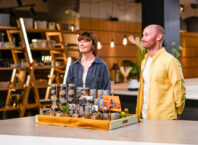The Natural History Museum’s free display ‘Our Broken Planet: How We Got Here and Ways to Fix It’ is set to close on 29 August, after receiving over a million visitors since opening in May last year. The display consists of over 40 objects chosen by Museum scientists, which reveal the environmental consequences of our actions and examine some of the solutions that could help mend our broken planet.
Some stand-out specimens in the display include:
· A 3m long black marlin skeleton.
· A Chinese mitten crab pulled from the Thames alongside a ball of over 100 plastic fibres removed from its stomach.
· A whale earwax plug, which has been analysed by Museum scientists who identified toxins including DDT and PCBs, used in paints, plastics and as pesticides.
· A juvenile European bison, telling the story of an experimental rewilding project in Kent that will investigate if bison feeding habits will improve the forest’s biodiversity and store more carbon in the soil.
· The recently extinct Chinese paddlefish, a casualty of the global boom in hydroelectric dams.
To promote the final weeks of Our Broken Planet, two 3D posters featuring recycled materials have been created, one in Limehouse and one in Camberwell. The Limehouse installation consists of a billboard alongside a cycleway, with the Our Broken Planet text supplemented by recycled plastic waste, a symbol of the unsustainability of single-use and disposable plastics.
The Camberwell installation consists of a 6-sheet poster made entirely of recycled posters from former adverts and campaigns. The Our Broken Planet text and graphics have been hand-painted over the top of the recycled posters to avoid the use of damaging aerosols such as spray paints.
Dr Alex Burch, Director of Public Programmes at the Natural History Museum, says: ‘Our Broken Planet has been a huge success for the Museum, attracting over 1 million visitors. The specimens on display combined with the Museum’s scientists and scientific research tell powerful stories about the impact we’ve had on our planet and the solutions that exist, inspiring visitors to care and take action for the world around us.’




